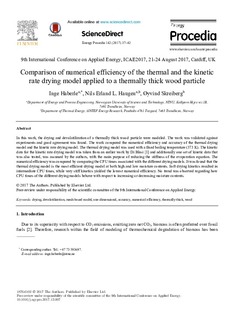| dc.contributor.author | Haberle, Inge | |
| dc.contributor.author | Haugen, Nils Erland L | |
| dc.contributor.author | Skreiberg, Øyvind | |
| dc.date.accessioned | 2018-02-02T08:25:35Z | |
| dc.date.available | 2018-02-02T08:25:35Z | |
| dc.date.created | 2017-08-27T16:24:58Z | |
| dc.date.issued | 2017 | |
| dc.identifier.citation | Energy Procedia. 2017, 142 37-42-?. | nb_NO |
| dc.identifier.issn | 1876-6102 | |
| dc.identifier.uri | http://hdl.handle.net/11250/2482306 | |
| dc.description.abstract | In this work, the drying and devolatilization of a thermally thick wood particle were modeled. The work was validated against experiments and good agreement was found. The work compared the numerical efficiency and accuracy of the thermal drying model and the kinetic rate drying model. The thermal drying model was used with a fixed boiling temperature (373 K). The kinetic data for the kinetic rate drying model was taken from an earlier work by Di Blasi [1] and additionally one set of kinetic data that was also tested, was assumed by the authors, with the main purpose of reducing the stiffness of the evaporation equation. The numerical efficiency was compared by comparing the CPU times associated with the different drying models. It was found that the thermal drying model is the most efficient drying model at both high and low moisture contents. Soft drying kinetics resulted in intermediate CPU times, while very stiff kinetics yielded the lowest numerical efficiency. No trend was observed regarding how CPU times of the different drying models behave with respect to increasing or decreasing moisture contents. | nb_NO |
| dc.language.iso | eng | nb_NO |
| dc.publisher | Elsevier | nb_NO |
| dc.rights | Attribution-NonCommercial-NoDerivatives 4.0 Internasjonal | * |
| dc.rights.uri | http://creativecommons.org/licenses/by-nc-nd/4.0/deed.no | * |
| dc.title | Comparison of numerical efficiency of the thermal and the kinetic rate drying model applied to a thermally thick wood particle | nb_NO |
| dc.type | Journal article | nb_NO |
| dc.type | Peer reviewed | nb_NO |
| dc.description.version | publishedVersion | nb_NO |
| dc.source.pagenumber | 37-42-? | nb_NO |
| dc.source.volume | 142 | nb_NO |
| dc.source.journal | Energy Procedia | nb_NO |
| dc.identifier.doi | 10.1016/j.egypro.2017.12.007 | |
| dc.identifier.cristin | 1488866 | |
| dc.relation.project | Norges forskningsråd: 243752 | nb_NO |
| dc.description.localcode | © 2017 The Authors. Published by Elsevier Ltd. This is an open access article under the CC-BY-NC-ND 4.0 license (http://creativecommons.org/licenses/by-nc-nd/4.0/) | nb_NO |
| cristin.unitcode | 194,64,25,0 | |
| cristin.unitname | Institutt for energi- og prosessteknikk | |
| cristin.ispublished | true | |
| cristin.fulltext | original | |
| cristin.qualitycode | 1 | |

